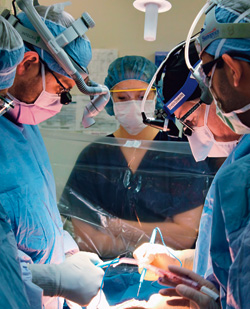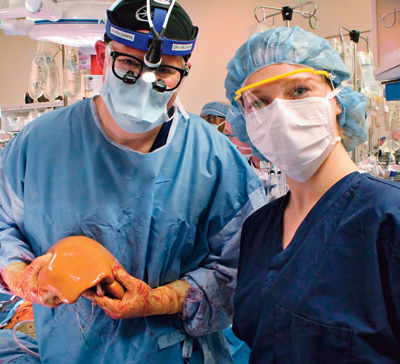Mar 28, 2014
A Valuable Mentor
“I met Dr. Chavin during an externship my sophomore year. The experience inspired me to apply to MUSC’s summer undergraduate research program. I was…

Dr. Kenneth Chavin ’83, P’16 describes transplant procedure to Emily Oliver ’17.
by Kevin Gray, photos by Riviere Propst, Medical University of South Carolina Department of Surgery
“As a parent, the transplants that involve children really hit my heart.” Dr. Kenneth Chavin ’83 was reflecting as he prepared to fly from his base at the Medical University of South Carolina (MUSC) in Charleston to another hospital in South Carolina. His mission was to divide a donated liver into two pieces and transplant a segment of it into a baby that evening.

Emily Oliver ’17 observes surgery as Dr. Chavin teaches about the method and parts of the liver.
“It’s a privilege and an honor that patients and their families who are facing life and death situations trust me and our team to get them through this very difficult time in their lives and to give them a new lease on life with an organ transplant,” he says.
Chavin, who has participated in more than 800 liver transplants and 1,000 kidney transplants, is moved as he talks about sharing a video with a young colleague recently. Created 16 years ago, it details the first organ transplant from a living donor performed at MUSC. A young girl receives a transplant from her father, who donated the left lobe of his liver. Suffering from the acute onset of liver failure, the girl would have died within 48 hours of the filming, Chavin says, had she not received the transplant.
“After the surgery, she was in a coma and woke up about 48 or 72 hours later,” Chavin says. “Her father was already recovering and able to be at her bedside when she woke up. She is now a senior in high school, ready to graduate and go to college. She runs for her school’s championship cross-country team, and her father still runs with her. To see the life she’s lived is extremely gratifying.”
It’s not surprising that Chavin relishes sharing this powerful testament to the impact transplant surgeons can have on lives. He embraces the role of mentor. For the past six years, he has hosted Lafayette interns and externs at MUSC.
“I went on an externship in South Carolina to shadow a surgeon who does liver and kidney research. That week changed my life.”
—EMILY OLIVER ’17
“I loved my time at Lafayette,” he says. “It altered my life and helped put me on the trajectory to where I am today. I’m happy to give back. It’s a great opportunity, and we love having them.”
The value of the experiences, he says, is in giving students a firsthand look at their possible career that can validate or refute their thinking about entering the field. He adds that his timeframe for hosting these experiences has expanded as his daughter Sammy, a sophomore majoring in neuroscience at Lafayette, has referred some of her friends in premed to her father.
“Lafayette students come at all times of the year,” he says. “For example, they will spend a week with Sammy when she’s home for summer, so it’s become even more special.”
Chavin, who earned his medical degree at Temple University, is the third generation of his family to become doctors, following his father and grandfather. At Lafayette, he did research on tissue culture and virology with Shyamal Majumdar.

Dr. Kenneth Chavin ’83 explains liver characteristics to Emily Oliver ’17, a biochemistry major, during an externship in January.
“Being able to do research as a sophomore, junior, and senior—and to do my honors thesis—all prepared me for another side of my career, which is the basic science lab I have here. In it, Ph.D. students ask basic translational questions for clinical problems,” he says. Chavin himself earned a Ph.D. in immunology from MUSC during his residency because he was able to pursue research while doing the clinical training. “I would credit Lafayette for a lot of that,” he says.
“What’s cool is that when I brought Sammy to Lafayette for freshman orientation, Dr. Majumdar was there, so she got to meet my research mentor for my undergraduate education,” he adds proudly.